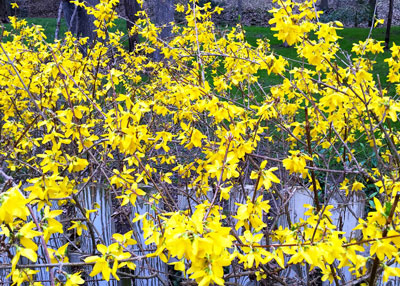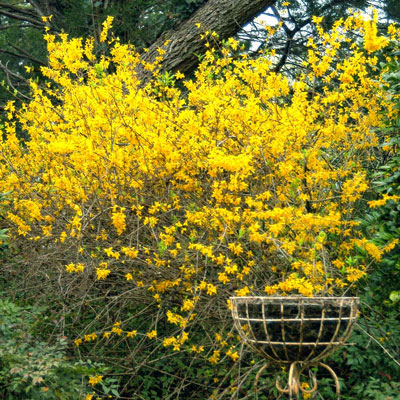A Personal Favorite: Forsythia

Photo: The fence will get painted after this year’s bloom. That’s also the prime time to reshape forsythias.
I grew up in Texas, and I really never saw many forsythias. Maybe I wasn’t looking, but then again, I’ve been all about plants as long as I can remember. If forsythias were there in College Station back then, I think I’d have seen them. And I don’t recall that they were in our plant materials classes I took in horticulture at Texas A&M at that time, either.
And then I moved up north to finish my undergrad and grad degrees at Ohio State, and forsythias were just about everywhere. I even ended up using them as one of my main plants in my graduate research.
It’s safe to say that I love forsythias. So when Lynn and I moved to DFW in 1970, they were some of the first shrubs that I planted. And those early plantings are still out there in our gardens looking great every spring. They aren’t in bloom yet in the Metroplex, but since they either are, or soon will be in flower in South Texas, I decided to include them here this week.

Photo: Another planting of forsythias on the opposite side of our landscape (2015). I have plants in six or eight places. Did I tell you that I love forsythias?
There are many selections of forsythias in the marketplace. Look for names like Lynwood Gold and Spring Glory among the larger types (to 5 to 7 feet tall and wide) and Arnold Dwarf (to 2 to 3 feet tall), among many others. Newer named hybrids are showing up every year, and they all are appealing to my gardening eye.
All forsythias grow best in rich, highly organic soils that can be kept uniformly moist throughout the growing season. They require full or nearly full sun for best performance.
Forsythias are deciduous, so it’s best to use them in front of larger dark green evergreens that can pick up the slack when the forsythias drop all their leaves in the winter. As deciduous, spring-flowering shrubs go, they’re some of the better looking ones when out of bloom, so you don’t have to hide them way back in the alley. But you probably don’t want them right alongside the front door, either.
About the only insect or disease that I’ve ever seen bothering them is the soil-borne fungus known as cotton root rot. I have one spot in our landscape where I lost one, and I’ve been careful not to plant another one back near that area.
Apply an all-nitrogen fertilizer to your forsythia soon after it finishes blooming. That’s also when you would prune and reshape the plant (hopefully not into a cube or a globe). Use hand shears for the best look.
Forsythias are easily rooted from cuttings, or many types can be tip-layered by pegging their arching stems against moist ground.
Or of course, you can resort to the old-fashioned way and buy your plant at the garden center. But don’t wait too long. Once they start to arrive they sell out very quickly. (Often to me! I’m easy prey.)
